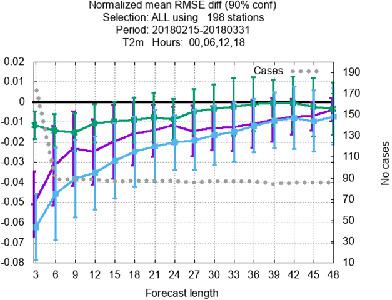当前位置:
X-MOL 学术
›
Q. J. R. Meteorol. Soc.
›
论文详情
Our official English website, www.x-mol.net, welcomes your
feedback! (Note: you will need to create a separate account there.)
Relative impact of observations on a regional Arctic numerical weather prediction system
Quarterly Journal of the Royal Meteorological Society ( IF 3.0 ) Pub Date : 2021-03-17 , DOI: 10.1002/qj.4018 Roger Randriamampianina 1 , Niels Bormann 2 , Morten Andreas Ødegaard Køltzow 1 , Heather Lawrence 2, 3 , Irina Sandu 2 , Zheng QiWang 1
Quarterly Journal of the Royal Meteorological Society ( IF 3.0 ) Pub Date : 2021-03-17 , DOI: 10.1002/qj.4018 Roger Randriamampianina 1 , Niels Bormann 2 , Morten Andreas Ødegaard Køltzow 1 , Heather Lawrence 2, 3 , Irina Sandu 2 , Zheng QiWang 1
Affiliation

|
The impact of Arctic conventional and satellite observations on regional short-range weather forecasts is assessed using observing-system experiments, in which observations are removed (denied) when creating the initial conditions of the forecasts. The experiments are conducted with the AROME-Arctic regional mesoscale numerical weather prediction system, using as lateral boundary conditions (LBCs) observing-system experiments performed at the European Centre for Medium-Range Forecasts (ECMWF) with the global forecasting system. This allows the assessment of the relative impacts of observations on forecast skill through regional data assimilation (DA), through LBCs, and the total impact due to the denial of observations in both the regional and global forecasting systems. The study is conducted during the first and second Special Observing Periods of the Year Of Polar Prediction. The total impact on the upper-air forecasts is dominated by the impact of observations through their assimilation in the LBCs, while for the winter period the impact on surface fields is dominated by the regional DA. The latter is significant up to 36 hr, while the former impact can last throughout the verified forecast range (48 hr). The use of observations in the LBCs has both significantly positive and significantly negative impacts. In terms of total impact on forecast skill, conventional observations, followed by infrared radiances, have the largest impact on all upper-air parameters, except for humidity. For upper-air humidity forecasts, the microwave radiances have the largest impact. In terms of observation impact through regional DA, conventional observations play the largest role for upper-air temperature and geopotential, microwave for upper-air humidity, and atmospheric motion vectors and Infrared Atmospheric Sounding Interferometer (IASI) for wind forecast. Regional DA of conventional observations also contributes the most to improvements of surface fields, except for 10-m winds, for which the microwave temperature-sensitive radiances are the most important.
中文翻译:

观测对区域北极数值天气预报系统的相对影响
北极常规和卫星观测对区域短期天气预报的影响使用观测系统实验进行评估,其中在创建预报的初始条件时移除(拒绝)观测。这些实验是使用 AROME-北极区域中尺度数值天气预报系统进行的,使用横向边界条件 (LBC) 观测系统实验,在欧洲中期预报中心 (ECMWF) 使用全球预报系统进行。这允许通过区域数据同化 (DA) 和 LBC 评估观测对预报技能的相对影响,以及由于区域和全球预报系统中的观测被拒绝而造成的总影响。该研究是在极地预测年的第一和第二个特别观测期进行的。对高空预报的总影响主要受通过 LBC 同化观测的影响,而在冬季期间,对地表场的影响主要受区域 DA 的影响。后者长达 36 小时,而前者的影响可以持续整个经过验证的预测范围(48 小时)。在 LBC 中使用观察结果既有显着的积极影响,也有显着的消极影响。就对预报技能的总体影响而言,常规观测,其次是红外辐射,对除湿度外的所有高空参数影响最大。对于高空湿度预报,微波辐射的影响最大。在区域 DA 的观测影响方面,常规观测对高空温度和位势、微波对高空湿度、大气运动矢量和红外大气探测干涉仪(IASI)对风预测的影响最大。常规观测的区域 DA 也对地表场的改善贡献最大,但 10 米风除外,其中微波温度敏感辐射最为重要。
更新日期:2021-03-17
中文翻译:

观测对区域北极数值天气预报系统的相对影响
北极常规和卫星观测对区域短期天气预报的影响使用观测系统实验进行评估,其中在创建预报的初始条件时移除(拒绝)观测。这些实验是使用 AROME-北极区域中尺度数值天气预报系统进行的,使用横向边界条件 (LBC) 观测系统实验,在欧洲中期预报中心 (ECMWF) 使用全球预报系统进行。这允许通过区域数据同化 (DA) 和 LBC 评估观测对预报技能的相对影响,以及由于区域和全球预报系统中的观测被拒绝而造成的总影响。该研究是在极地预测年的第一和第二个特别观测期进行的。对高空预报的总影响主要受通过 LBC 同化观测的影响,而在冬季期间,对地表场的影响主要受区域 DA 的影响。后者长达 36 小时,而前者的影响可以持续整个经过验证的预测范围(48 小时)。在 LBC 中使用观察结果既有显着的积极影响,也有显着的消极影响。就对预报技能的总体影响而言,常规观测,其次是红外辐射,对除湿度外的所有高空参数影响最大。对于高空湿度预报,微波辐射的影响最大。在区域 DA 的观测影响方面,常规观测对高空温度和位势、微波对高空湿度、大气运动矢量和红外大气探测干涉仪(IASI)对风预测的影响最大。常规观测的区域 DA 也对地表场的改善贡献最大,但 10 米风除外,其中微波温度敏感辐射最为重要。











































 京公网安备 11010802027423号
京公网安备 11010802027423号